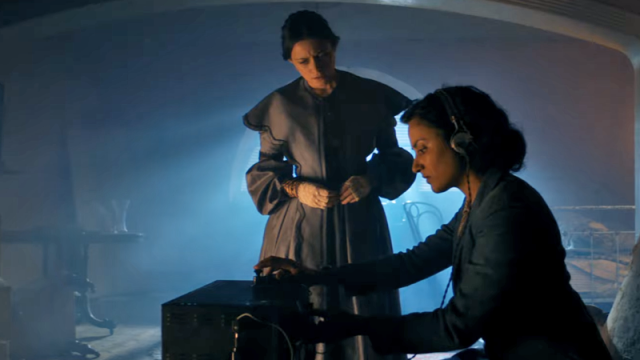Last week’s Doctor Who episode provided a tantalising new arc and a darker path for the 13th Doctor to go on. It also had some…let’s say interesting moments set in World War II Paris, moments that could’ve been even more interesting if a planned death scene apparently cut from the episode had made it in.
“Spyfall, Part Two” saw the Doctor, without her TARDIS, flung across time and space in an attempt to chase down the latest incarnation of her greatest frenemy, the Master. After a quick stop in 19th century London to pick up foremost computer scientist and inventor Ada Lovelace, the Doctor’s quest eventually brought her to Paris at the height of the Second World War in 1943. There, she teams up with another prominent female figure of history: Noor Inayat Khan (played by Aurora Marion), an Indian-American descended from nobility and a wireless operator for the Special Operations Executive, the first female operative sent by the SOE into occupied France to aid the resistance.
[referenced url=” thumb=” title=” excerpt=”]
By the time the Master’s plan is foiled and the day is saved, the Doctor has to return her new historical friends to their place in time, as well as erase their memories of their adventures together to avoid disrupting history more than it had been already. For Noor, this is especially heartbreaking—moments before the Doctor erases her memory, she innocently asks if there is hope to be found among the misery of wartorn France, only for the Doctor to tell her that the Nazis don’t win, and fascism will always be defeated wherever it rises. A fact that Noor won’t actually get to remember.
The real Khan didn’t live to learn this truth, either. She was arrested—believed to be betrayed by a member of the French Resistance acting as a double agent—in late 1943. On September 13, 1944, a year after the events shown in “Spyfall,” Khan was executed alongside three other female SOE agents at the Dachau concentration camp in Bavaria, Germany. She was just 30.
It is a death, according to Marion, we nearly saw play out in the episode itself. As spotted by the Radio Times, the actress took to Instagram in the wake of her appearance on the show to thank fans for the reaction to her portrayal of Khan. But in doing so, she also revealed something surprising: she shot a death scene for the episode that was ultimately cut.
“My first time as a period character, my first time on a show of this scale, my first death by guns on set (Noor got shot by the nazis, not in the final cut though),” Marion wrote. “I feel ever so grateful to have spent a few days in Cardiff to shoot these impressive scenes and to have met all these incredible beings there.”
It’s hard to say just when a death scene for Noor could’ve been inserted into the episode. It’s already grim enough, with the Doctor having to wipe Noor’s memory of being told her work wasn’t in vain and that the Nazis would be defeated. Would we really need to flash foward to Noor’s execution to hammer that tragedy home? Would it be worth presenting an ahistorical interpretation of her death, considering Doctor Who went out of its way to consider “fixing” the timeline in the first place to account for Noor and Ada being wrenched out of their time periods by the Doctor?
Temporal logistics aren’t the only concern raised around the cutting of this death scene. The episode has faced considerable criticism for other elements of its World War II scenes, most notably the fact that the Master—now played by Sacha Dhawan—openly collaborates with Nazi forces in the episode to hunt the Doctor down, embedding himself as an SS Officer. To hide the fact that his current regeneration is not white, the Master projects a psychic perception filter into the minds of the Nazis around him. But in her escape (having had Noor send an easily-traceable message outing the Master’s officer as an alleged Nazi traitor feeding information to the British) from his clutches, the Doctor disables this filter, exposing the Master to his Nazi captors as a person of colour.
[referenced url=” thumb=” title=” excerpt=”]
It’s an extremely disconcerting moment, considering the Doctor’s escape plan already assured the Master would fall foul of his “allies,” an incredibly cruel and out-of-character moment for a show and hero that has always championed diversity in the face of hatred and bigotry. Combining a moment like that with the needless presentation of another prominent person of colour’s execution at the hands of the Nazis would’ve been a step even further in the wrong direction. At least, somewhere down the line, that particular decision was left on the cutting room floor.
